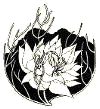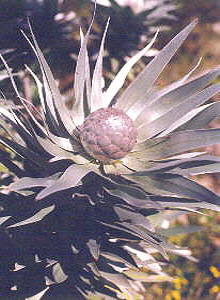
Home
Mission
Overview of Project
Project Staff
Sponsors
Achievements
Checking, Illustrations
Upcoming Activities
Id and Species Lists
Protea Information
Protea Gallery
Growing Proteas
Interim Dist. Maps
Publications
Afrikaanse Inligting
![]()
A Genetic Disaster?
 I recently came across
somebody who was telling me they were planting Leucadendron
argenteum on Vlakkenberg after the big fire of January 2000. The plants were sourced
from the Kirstenbosch population. How advisable is this? Does this mess up the genetic
biodiversity?
I recently came across
somebody who was telling me they were planting Leucadendron
argenteum on Vlakkenberg after the big fire of January 2000. The plants were sourced
from the Kirstenbosch population. How advisable is this? Does this mess up the genetic
biodiversity?
Nigel Forshaw, Oakridge
This phenomenon is part of a bigger problem. People understand that every plant labelled as "indigenous" can be planted because it is "born, produced or belongs naturally in a region." If it belongs naturally in the region, then surely you can plant it with a free conservation conscience.
The definition though is very vague on the word "region." This is where, I think, most people come unstuck. All plants and animals are indigenous to the Earth. Some are indigenous to South Africa. Some plants indigenous to South Africa are indigenous to the Western Cape. Some of these Western Cape species are indigenous to the Cape Peninsula. Similarly, not all species indigenous to the Peninsula are indigenous to Oakridge. However, it seldom matters, since urban gardens are not critical in any way, and planting "indigenous plants" is a personal choice. It matters to no one except the gardener if his definition of indigenous means "Earth", "Africa", "Peninsula" or even "Oakridge" based on Purcell’s Bergvliet plant list.
 However,
when establising plants in conservation areas, we have to be very much more specific. A
plant species indigenous to Swellendam, just around the "corner" may or may not
be indigenous to Cape Town. But with 2200 species on the Cape Peninsula, of which over 200
are in the Red Data Book for plants, we cannot afford to compromise these species by
introducing weeds. Some of these weeds are indigenous to the Western Cape and grow well at
Betty’s Bay and Hermanus, but they are aliens on the Peninsula. If planted they may
compete and displace plants that are indigenous to the Peninsula and may result in their
extinction. In this regard they are as alien, as invasive, and as undesirable as plants
indigenous to Australia (Needlebushes, Wattles) or California (Pines). What is more, they
need to be removed with the same enthusiasm and zeal as the other exotic aliens.
However,
when establising plants in conservation areas, we have to be very much more specific. A
plant species indigenous to Swellendam, just around the "corner" may or may not
be indigenous to Cape Town. But with 2200 species on the Cape Peninsula, of which over 200
are in the Red Data Book for plants, we cannot afford to compromise these species by
introducing weeds. Some of these weeds are indigenous to the Western Cape and grow well at
Betty’s Bay and Hermanus, but they are aliens on the Peninsula. If planted they may
compete and displace plants that are indigenous to the Peninsula and may result in their
extinction. In this regard they are as alien, as invasive, and as undesirable as plants
indigenous to Australia (Needlebushes, Wattles) or California (Pines). What is more, they
need to be removed with the same enthusiasm and zeal as the other exotic aliens.
In fact ‘indigenous’ aliens may be far more of a danger. Whereas Needlebushes will not breed with any proteas indigenous to the Cape Peninsula, proteas from other areas in the Cape may form hybrids. These hybrids may not be easy to identify and local species may well become extinct, to be replaced by hybrid swarms. These changes may happen fast, they may easily be missed and they may be irrevocable.
At last we are ready to tackle Nigel’s question. The Silvertrees from Vlakkenberg are a population quite distinct from those of Kirstenbosch. One could argue that the population from Kirstenbosch is not indigenous to Vlakkenberg. Does this matter? The answer is we don’t know. If we do not know we should apply the precautionary principle and play safe. It is possible that pollination and seed dispersal could make the Vlakkenberg plants part of the same population as those from Wynberg and Kirstenbosch. They could share the same genes and adaptations and therefore it would not matter if we moved plants around. On the other hand, Vlakkenberg could be a tougher environment than Kirstenbosch, and the populations of Vlakkenberg might not exchange genes with those from Wynberg and Kirstenbosch. They may also have special genes to adapt them to the environment at Vlakkenberg. Introducing Kirstenbosch genes may well result in less fit plants that will become extinct. Because we don’t know for sure one way or the other, we should apply the precautionary principle and all plants obtained from Kirstenbosch should be pulled up as soon as possible. If the Vlakkenberg population requires augmentation (and who has established that it does?), then seeds from Vlakkenberg should be the source of choice. [I will not deal with problems of pathogen and "alien" soil fungi and animals in potted plants and the irresponsibility of not maintaining adequate sterility under these conditions].
However, in the case of Silvertrees, two things suggest that we need not be too concerned by these conservation-irresponsible actions. Firstly, just 100 years ago the Witteboom populations were probably continuous from Vlakkenberg to Devil’s Peak. The separate populations we know today are due to plantations, agriculture and urbanization. Thus it is likely that the genetic and adaptational differences between the populations will not be too extreme. Secondly, Cape Town City horticulturalists have planted thousands of Silvertrees over the Peninsula, with little thought to where the seeds came from or even if the habitat was suitable. Any genetic differentiation of populations would have been wiped out during the 20th Century, leaving us with a genetic mess anyway. (We could conjecture that this meddling might be why Vlakkenberg populations require augmentation but that would be pure speculation).
There are two other spin-offs from this question.
- People often muddle up "indigenous" to mean the same as "suitable". Thus if a plant is indigenous to the Peninsula, we can plant it on the Peninsula. But even if the plant was in Purcell’s Bergvliet list, this does not mean we can plant it in a hypothetical nature reserve at Bergvliet. Forest trees do not belong in Fynbos, and planting Fynbos plants in Thicket areas is just wasting money. The planting of indigenous trees in Fynbos will contribute to uncontrollable fires just as much as Pine and Wattles will! Wetland plants belong in a wetland – species must be matched to their habitats.
- The last spin-off is how long must a species occur in a region before we consider it to be "indigenous." After all we consider ourselves Capetonians after only 400 years, but still consider Pines as aliens. I think that the only valid criteria for an exotic species to be considered "indigenous" is when it has become integrated into the ecology of the area so that it does not threaten other species or change key ecological processes. For this to occur it must have a suite of biocontrol agents (preferably indigenous, but alien will do!) that keep it in ecological balance with the rest of the ecosystem. A simple qualification will be – "Do we need to spend more money or effort on its eradication?" If the answer is that the species will not negatively impact on other species and ecosystems if we stop managing it, then we can consider it an integrated species adapted to its community. We can then consider it "indigenous." Thus Ha sericea is almost indigenous, perhaps only 100 more years are required. Note that by this definition, we are not indigenous! Arrogant – Yes. Indigenous – NO!
Tony Rebelo
Back PAN 52